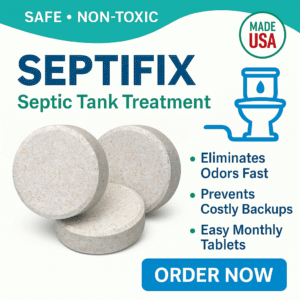Ever heard the term “septic shock treatment” and wondered what it really means? It’s not about humans—it’s a super‑charged burst of microbial or enzyme power sent into your septic system to tackle stubborn blockages, odors, or drain field problems quickly.
This guide explains when a septic shock treatment might make sense, how it works, its potential downsides, and why a cleaner, simpler option like SEPTIFIX may give you the same results with far less hassle.
What Is a Septic “Shock” Treatment?
Shock treatments deliver a large, concentrated dose of bacteria and/or enzymes to your septic system. The goal is to:
- Jump‑start a failing system
- Break down heavy sludge or hardened build‑up
- Clear sluggish drain fields or reduce odors fast
For example, SeptiMax and SeptiDrain (from a product line) offer a two‑step shock process: one product disperses surface layers, while the other delivers an intense dose of bacteria to restore biological balance.
Popular Shock Treatment Products
Some widely used options include:
- Instant Power Septic Shock: Boasts enzymes and live bacteria to dissolve organic materials, open clogged drain fields, and eliminate odors. No acids or harsh chemicals.
- Septi-Flow Shock: Features calcium polysulfide chemistry to loosen compacted soil in clogged drain fields, restoring water flow.
- NT‑MAX Shock System: A two-step biological treatment—biobags or liquid—used first in shock mode and then as monthly maintenance to restore and sustain septic activity.:
Pros and Cons of Shock Treatments
| Pros | Cons |
|---|---|
| Quickly addresses blockages, odors, and failing systems | Can disrupt the natural bacterial balance |
| High‑strength dose targets buildup in tanks or fields | Temporary fix—maintenance habits still crucial |
| Effective in emergency or serious slow-down situations | Cost and use frequency may not align with regular maintenance |
What Real Users and Experts Say
“At best, shock treatments do little—and at worst they speed solids into the drain field, causing clogging.”
“These additives rarely help much—proper routine pumping and avoiding harsh cleaners do a lot more.”
When Might You Need a Shock Treatment?
- Severe clogging in drain lines or field
- Persistent odors despite regular maintenance
- System is newly pumped and needs a strong restart
- Agreed upon by a septic professional as emergency action
Remember: These treatments are short-term fixes—not replacements—for good habits and regular pump-outs.
A Cleaner, Maintenance-Friendly Alternative: SEPTIFIX
If you’re looking for consistent, low-effort support, SEPTIFIX shines:
- Flushable tablet—no mixing, no mess
- Fast, oxygen-powered odor control in 3–5 days
- Breaks down grease, sludge, and toilet paper
- Supports healthy bacteria and balances tank pH
- Safe, eco‑friendly, and reliable when used monthly
Try SEPTIFIX now for easier, safer septic maintenance.
Final Thoughts
Septic shock treatments can be powerful tools in emergencies—but they come with risks and should be treated as short‑term solutions. For most homes, steady maintenance (correct flushing habits and scheduled pump-outs) does more for system health.
That said, if occasional system support makes sense for your household, SEPTIFIX delivers smart, gentle reinforcement month after month—no shocks needed.
